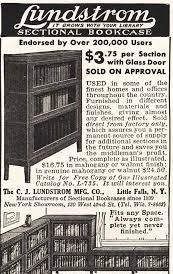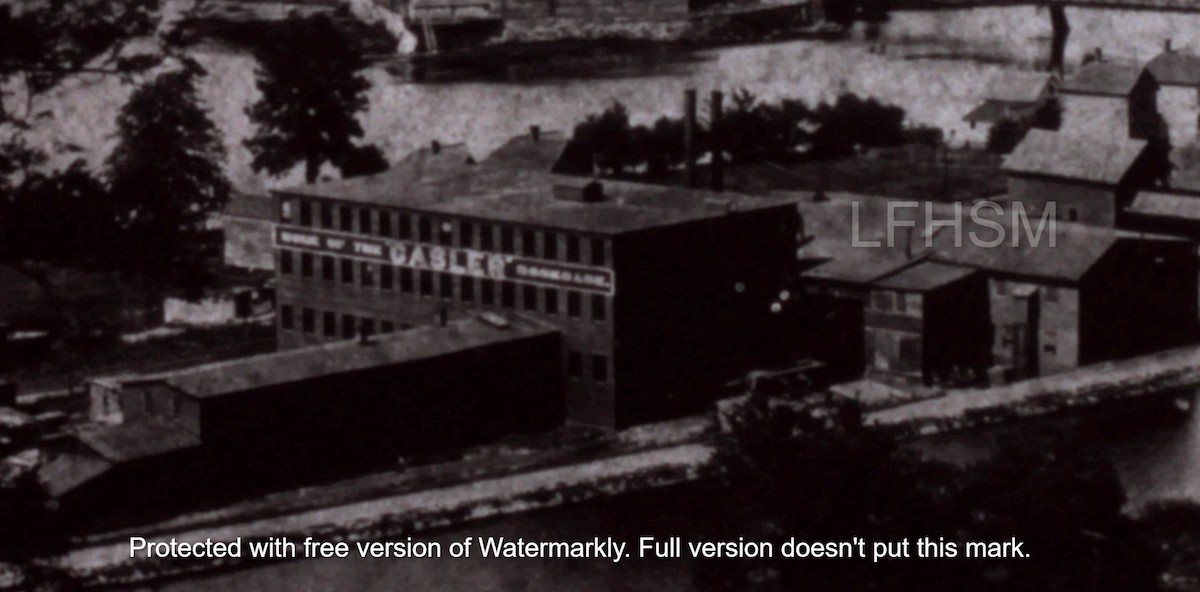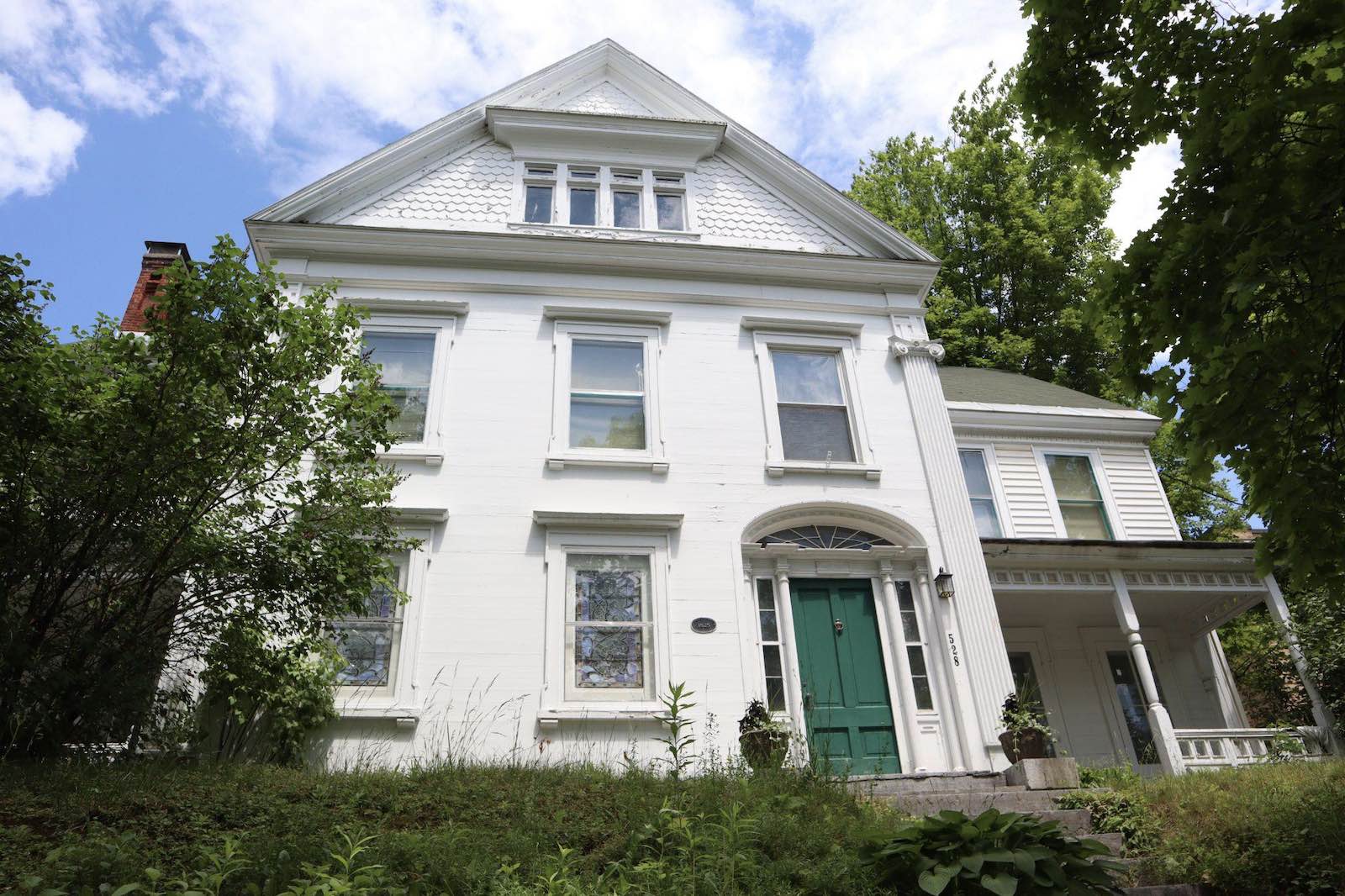Patent Attorney C. J. Lundstrom is completing arrangements to start a factory in Little Falls to manufacture his patent filing cases.
“Hitherto, Mr. Lundstrom has had them manufactured for him, together with his patent bookcases, at the P. W. Casler plant.”
February 20, 1903, Cooney Archives
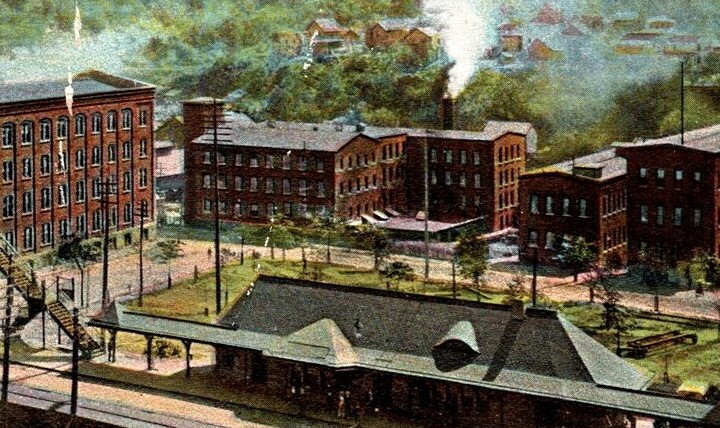
c. 1910 Postcard of C. J. Lundstrom Manufacturing Company – being the brick mill in the middle of the background of the postcard
CARL JOHAN LUNDSTROM
C.J. Lundstrom was the son of Carl Johan and Rosalie Schadard Lundstrom. He was born on the 23rd of April 1869 at Stockholm, Sweden.
Lundstrom came to the United States in 1889, accepting a work position with David Hamlin Burrell, as a draftsman and inventor. He stayed in Burrell’s employ for next five years, then he branched off independently as a patent attorney.
Lundstrom served on the school board for two years as commissioner, attended the First Presbyterian Church, and was a member of the Order of the Elks. He enjoyed traveling, stateside and abroad and also enjoyed outdoor sports, especially golf.
On the 3rd of October 1893, Lundstrom married Gertrude May Opal, daughter of George Anton SR and Elizabeth Oppel, who were proprietors of Oppel’s Jewelry shop. They had three sons, namely, Valford Oppel in 1894, Birger Irving in 1897, and Carl Brynolf in 1899. In 1904, the family settled at 565 East Ganesvoort Street, which they inherited at the death of Gertrude’s father, George A. Oppel.
Gertrude’s death came in 1920, with Lundstrom remarrying in Stockholm, on the 15th of November 1921 to Siri Hess. They had a son, Carl Frederick, on the 22nd of December 1922. In 1933, Lundstrom purchased the home of Carl Brynolf, his son, being the former home of Col. David Petrie at 528 Garden Street. Carl Johan Lundstrom’s death was on the 17th of April 1943 and he is buried at Church Street Cemetery.
THE C.J. LUNDSTROM MANUFACTURING COMPANY
In 1899, Lundstrom began manufacturing bookcases at the factory of Philo William Casler, which was located on Southern Avenue, with Casler having had this street built at his own expense, in 1884. Lundstrom’s business began with a slow start and as the business grew, he was able to purchase the Saxony Mill in 1901. The mill was located at 523 East Mill Street, which is in the vicinity of the present-day site of George’s Lumber.
He received a patent in 1902, for the sectional Barrister Law Bookcase, which was built from oak and in the mission style. He not only received patents for furniture throughout the years, but also received patents under his name for a cream separator and dairy equipment.
By 1904, he had moved the company into the Saxony Mill on East Mill Street. Lundstrom organized the business into a stock company, with $120,000. in capital, being the C.J. Lundstrom Manufacturing Company. Besides bookcases, the company manufactured tables, file cabinets and cabinetry, with at one time manufacturing victrola cases for the Victor Talking Machine Company.
Lundstrom sold his furniture directly to the consumer, with no middleman to cut into the profits, where he was able to keep his products at reasonable prices. Lundstrom’s manufacturing business was very successful, with the CJ Lundstrom Manufacturing Company becoming well known globally.
SAXONY MILL
The Saxony Mill was built in 1850, by the Trumbull and French Company, to manufacture cloth and ingrain carpet. The company members were Earl Thumbull, Joseph French , Washington Van Dresen, J.N. Lake, Dexter Aldldrige. The woolen mill received its water power from the Mill Street raceway, which had been enlarged by contractor Earhardt in 1833.
The company was sold to Martin Priest in 1852, with him in turn, selling it a few months later to Seth Stitt. Stitt and A.G. Story were the first ones to develop a gas product at Little Falls, called naphtha gas, which they did in a small brick plant located along the back side of the Saxony Mill. In 1853, Stitt and Story obtained a franchise for the exclusive rights to lay gas piping throughout the village and to sell gas to the homeowners of Little Falls. Also that year, the Richmond’s started selling coal in the village, which they used the coal to burn the petroleum, to make the gas for gaslighting.
Stitt sold the woolen mill to Amos King, a textile manufacturer from Catskill, NY, on the 13th of February 1872. Amos, along with his son Charles King, manufactured woolen cloth for their first four years at the mill, then they modified the mill to produce knitwear. In 1901, the Saxony Mill was sold to Carl Johan Lundstrom for the manufacturing of bookcases.
*From The Cooney Archive’s: This Day In History by Louis Baum, Jr. Digitizing of historical photos by Gail & Mike Potter. Article written by Darlene Smith.
SOURCES:
https://www.donquigley.net/documents/3402_REF.pdf PG 298
https://herkimer.nygenweb.net/littlef…/littownprofile.html
https://herkimer.nygenweb.net/littlefalls/waterpower1.html
https://mycompanies.fandom.com/…/C._J._Lundstrom…
https://www.schenectadyhistory.org/…/lundstrom_carl.html
US762328A – Sectional bookcase
Historic Newspapers
The home at 528 Garden Street was built by Colonel David Petrie in 1828.
He purchased the lot on December 28, 1827, from Edward Ellice for $400. The lot contained two small homes. He must have been an influential citizen at that time, because the lot was only the third one sold by the Ellice Estate.
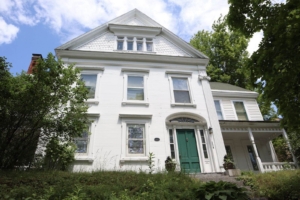
528 Garden Street
Petrie was the grandson of Dieterich Markus Petrie, who was killed at the Battle of Oriskany during the Revolutionary War. He was also the great grandson of Johan Jost Petrie, a noted Palatine German leader who established the first industry here around 1723, a grist mill at the mouth of Furnace Creek, along the Mohawk River. The mill was burned during the 1782 Petrie Grist Mill massacre. Daniel Petrie, Johan’s grandson, owned and ran the mill and was murdered by Loyalist, British and Indian soldiers. The location of the Petrie Mill is marked with a historical marker, which can be viewed at the intersection of West Mill Street and Elizabeth Street.
Colonel Petrie was born in 1792 on the family farm north of Little Falls. He fought in the War of 1812 and was married to Charlotte Hackley on September 30, 1824 by Reverend Spinner of the German Reformed Church in Herkimer. They had two daughters, one daughter dying at a young age and the other marrying a William Cressey and leaving the area.
Petrie came to Little Falls in 1825 to engage in the merchant business with his brother Joram. The business was located in the vicinity of the present-day Price Chopper Market. In 1838 they purchased the iron foundry of Sam Smith, which was located at the present location of the present-day shop of Sam’s Deli at the northeast corner of Furnace and Main Street. They manufactured and sold cast iron stoves, which were soon replacing brick and stone fireplaces for heating homes.
The brothers had a fleet of boats on the Erie Canal for the transportation of people and cargo. They realized that the new Utica and Schenectady Railroad in 1836 would curtail their transportation business on the canal, so they took their fleet of boats to the newly opened Toledo & Wabash Canal in the state of Ohio, to be sold.
The brothers sold their store in 1844 to William Wheeler. In 1856, the brothers sold the iron foundry, which gave Furnace Street its name.
Colonel David Petrie died of consumption on September 17, 1859. His house was then occupied by his nephew, Charles Lynds Petrie, who was a son of his brother Joram. Joram built the house at 77 North Ann Street in 1847. Charles was born in his father’s house and schooled at Cornell. He was admitted to the bar in 1876, but preferred the real estate and insurance business to practicing law. He married Fanny Rust, daughter of Nelson Rust and sister-in-law of Joshua Judson Gilbert. Charles Petrie was village president from 1889-1890. His death from Bright’s Disease was on April 21, 1914.
The next owner was a nephew of Mrs. Charles Petrie, Frederick Rust Van Vechten. Frederick married Alma Newell. They had a son and eventually moved away.
In 1928, Carl Lundstrom, of the Lundstrom Bookcase Factory, was living here with his son C. Brynolf Lundstrom. The Lundstrom Factory was in the former Saxony Mill on East Mill Street, where the present-day George Lumber is located. Lundstrom liked the house since he could see his factory from the porch.
Mr. Burnet Schneider purchased this home in 1951.
He was the Vice President of H. P. Snyder Manufacturing Company. Although the principal product of the Snyder Company through the years was bicycles, the company also made velocipedes and exercisers. During both World Wars a variety of products were produced for the United States Government.
The “Historic Homes & Places Self-Guided Walking Tour in Little Falls, New York” can be found at : https://littlefallshistoricalsociety.org/historic-homes…/
Learn more about Historic Little Falls, NY by visiting https://littlefallshistoricalsociety.org where you can find an online writing series, historical timelines, events, exhibits, and so much more.

